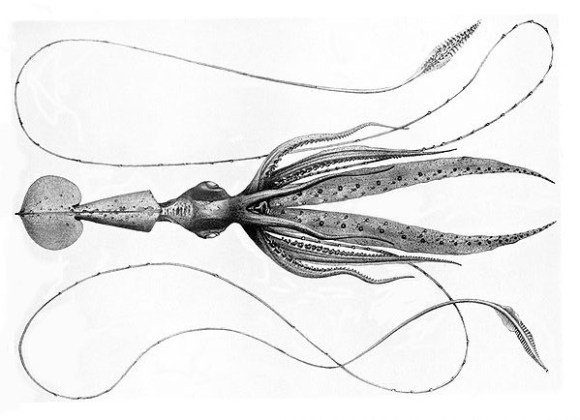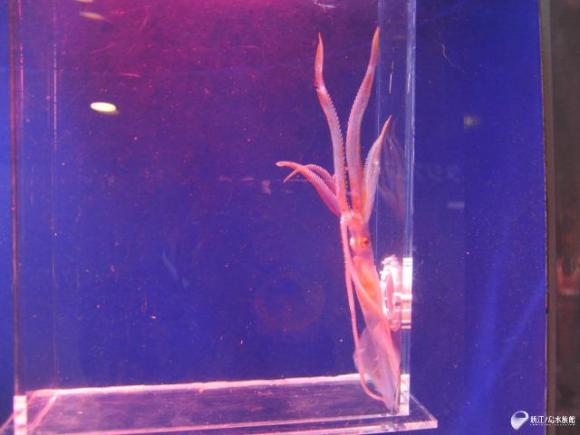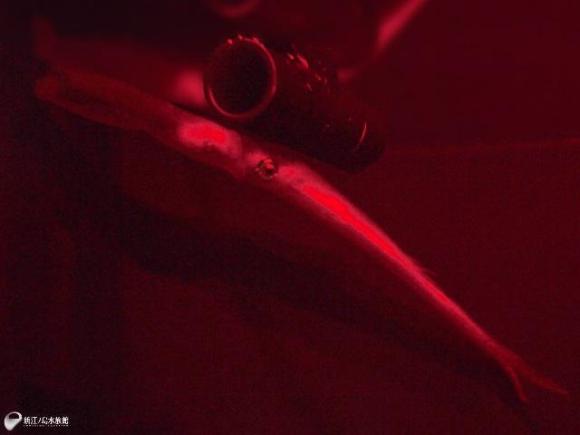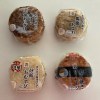 Deep below the ocean lives the squid Chiroteuthis, known in Japan by the name Yurei Ika (Phantom Squid). The Japanese name comes from its ghost-like fluttering and floating movement.
Deep below the ocean lives the squid Chiroteuthis, known in Japan by the name Yurei Ika (Phantom Squid). The Japanese name comes from its ghost-like fluttering and floating movement.
It’s a squid seldom seen by people who don’t have access to a submarine and can visit their habitat 200 to 600 meters beneath the ocean. So when they started turning up in unprecedented numbers around the southeastern coast of Japan, experts became understandably alarmed.
The phantom squid is not especially large at 60cm (body: 20cm), but even for a country very familiar with squid these guys are odd looking. They have 8 extremely thick tentacles, two of which are retractable, accompanied with two whip-like appendages.
Most people aren’t even aware of their existence, but the crew of a fishing vessel that scooped one up in their nets were on 15 November. Upon catching a living specimen they immediately sent it to the nearest aquarium, Enoshima Aquarium on the coast of Sagami Bay.
The aquarium welcomed this rarest of rare squid with open arms and prepared suitable living quarters. They equipped its tank with a dark red light to simulate its deep sea home and let them observe.
Sadly, the following day it died, likely as a result of the change in pressure. Marine ecologist, Masachika Tsuji explains:
“As far as I know, this is the first time to capture a live phantom squid. Usually, if deep sea fish come to the surface of the ocean then the lower pressure bursts their air bladder. However, because squid don’t have air bladders they can survive. That being said, coming to the surface causes considerable damage to their bodies. I have no idea why it came all this way.”
As the aquarium was lamenting their fleeting moment with such a rare creature the unexpected happened. The same day the museum was contacted about another fishing crew who caught another living phantom squid in Sagami Bay.
This time the museum was able to keep the squid alive for 3 days, but research on these creatures was extremely slim. Aquarium head keeper Madoka Kitajima tells the story:
“We tried feeding it different gobies and goldfish. We gave it a variety of thawed krill and herring, but it just wouldn’t eat. Phantom squid No. 2 came from off the coast of Atami and lived for 3 days, but it wouldn’t eat anything and died.”
As of 20 November there were two other phantom squids caught but they were not alive. It was also later discovered that back in October 10 phantom squid were discovered on the other side of Sagami Bay at Odawara Port.
So in the span of two months, 14 squid that are virtually never seen at the surface of the ocean were all caught within a limited area – an area which happens to be the location of the Great Kanto Earthquake of 1923. Mr. Tsuji is concerned.
“If it was just the one case on the 15th then it would have been written off as a fluke. But no longer, this must have been some kind of emergency evacuation from something major in the deep sea.
There seem to be many causes for the abnormal behavior of marine organisms. However, since the Tohoku Earthquake March 11 last year, there has been a growing risk of a massive earthquake epicenter in west Kanto. Most likely there could be crustal deformation of the seafloor in Sagami Bay.
In particular, it is also worrisome that the 1923 Great Kanto Earthquake which occurred off the coast of northwest Sagami Bay. One should also consider the Teishi Knoll undersea volcano that erupted in 1989 off the coast of Ito City in Shizuoka Prefecture. This may be a precursor to major volcanic activity in this area. The Phantom Squid may have begun to sense it.”
To make things more unsettling, last year we reported that an oarfish washed up on shore in Shizuoka Prefecture not too far from Sagami Bay on 21 December. In the article a reference was made to oarfish which washed up about year before the Tohoku Earthquake.
On the bright side, the fact that there is some major event under the ocean doesn’t necessarily mean it will have an impact to those of us on land.
To help lighten the mood I’ll leave you all with a fun science fact: the phantom squid are one of the few squid which has a penis. Most species of squid use their tentacles to impregnate females. G’night folks.
Source: Infoseek News via Hachima Kiko (Japanese)
Top Image: Wikipedia
Inset Images: New Enoshima Aquarium (Japnese)
Enoshima Aquarium (4 Phantom Squid Found November, 2012)
Odawara Port (10 Phantom Squid Found October, 2012)
Makinohara (1 Oarfish Found December, 2011)



 Japanese otter full of personality winning hearts over Twitter
Japanese otter full of personality winning hearts over Twitter We visit “the best conveyor belt sushi restaurant in Japan”
We visit “the best conveyor belt sushi restaurant in Japan” How to properly pronounce “Ghibli” and other fun trivia about the legendary animation studio
How to properly pronounce “Ghibli” and other fun trivia about the legendary animation studio That time Seiji called JASRAC to ask why he didn’t get paid royalties for his song being on TV
That time Seiji called JASRAC to ask why he didn’t get paid royalties for his song being on TV Pizza Hut Japan’s hot lucky bags are perfect for a New Year’s pizza party
Pizza Hut Japan’s hot lucky bags are perfect for a New Year’s pizza party Hayao Miyazaki says Happy New Year to Studio Ghibli fans with new art for Year of the Horse
Hayao Miyazaki says Happy New Year to Studio Ghibli fans with new art for Year of the Horse Should you warm up your convenience store onigiri rice balls in the microwave?【Taste test】
Should you warm up your convenience store onigiri rice balls in the microwave?【Taste test】 Japan’s hoya is a straight-up edible video game monster, and here’s how to prepare/eat it【Photos】
Japan’s hoya is a straight-up edible video game monster, and here’s how to prepare/eat it【Photos】 It’s like the samurai era never ended at this beautiful Japanese mountain town
It’s like the samurai era never ended at this beautiful Japanese mountain town Discover your secret charm at Kate’s mansion of emotions at Universal Studios Japan
Discover your secret charm at Kate’s mansion of emotions at Universal Studios Japan The ancient Japanese textile craft made with jagged fingernails
The ancient Japanese textile craft made with jagged fingernails Google made a free-to-play ninja cat RPG to celebrate the Tokyo Olympics, and it’s awesome!
Google made a free-to-play ninja cat RPG to celebrate the Tokyo Olympics, and it’s awesome! Dragon Quest Burgers and Slime drinks are coming to McDonald’s Japan【Video】
Dragon Quest Burgers and Slime drinks are coming to McDonald’s Japan【Video】 Starbucks Japan ready to get Year of the Horse started with adorable drinkware and plushies【Pics】
Starbucks Japan ready to get Year of the Horse started with adorable drinkware and plushies【Pics】 Cyberpunk anime meets traditional culture in Ghost in the Shell gold leaf Japanese changing screens
Cyberpunk anime meets traditional culture in Ghost in the Shell gold leaf Japanese changing screens 7 great places to see Mt. Fuji from without having to climb it
7 great places to see Mt. Fuji from without having to climb it Hello Kitty Choco Egg figures are an adorable trip through three periods of Japanese pop culture【Pics】
Hello Kitty Choco Egg figures are an adorable trip through three periods of Japanese pop culture【Pics】 7-Eleven Japan’s ramen-cooking robot whipped us up a bowl of noodles【Taste test】
7-Eleven Japan’s ramen-cooking robot whipped us up a bowl of noodles【Taste test】 We found possibly the quietest Japanese-style hotel in Tokyo’s bustling Shinjuku district
We found possibly the quietest Japanese-style hotel in Tokyo’s bustling Shinjuku district Japan’s otoshidama tradition of giving kids money at New Year’s gets a social welfare upgrade
Japan’s otoshidama tradition of giving kids money at New Year’s gets a social welfare upgrade Sumo Sanrio! Hello Kitty and pals team up with Japan Sumo Association for new merch【Pics】
Sumo Sanrio! Hello Kitty and pals team up with Japan Sumo Association for new merch【Pics】 More Than a Capsule Stay: Why Solo Travelers Choose “global cabin Yokohama Chinatown”
More Than a Capsule Stay: Why Solo Travelers Choose “global cabin Yokohama Chinatown” Japan’s oldest largetooth sawfish in captivity back on display in Mie Prefecture
Japan’s oldest largetooth sawfish in captivity back on display in Mie Prefecture 7-Eleven Japan starts new temporary luggage storage service in over 300 branches
7-Eleven Japan starts new temporary luggage storage service in over 300 branches Disillusionment at Tsukiji’s tourist-target prices led us to a great ramen restaurant in Tokyo
Disillusionment at Tsukiji’s tourist-target prices led us to a great ramen restaurant in Tokyo Starbucks teams up with 166-year-old Kyoto doll maker for Year of the Horse decorations【Photos】
Starbucks teams up with 166-year-old Kyoto doll maker for Year of the Horse decorations【Photos】 Tokyo considering law requiring more trash cans following litter increase in heavily touristed area
Tokyo considering law requiring more trash cans following litter increase in heavily touristed area Tokyo’s Tsukiji sushi neighborhood asks tour groups to stay away for the rest of the month
Tokyo’s Tsukiji sushi neighborhood asks tour groups to stay away for the rest of the month Tokyo event lets you travel back in time, for free, to celebrate 100 years since Showa era start
Tokyo event lets you travel back in time, for free, to celebrate 100 years since Showa era start Sanrio theme park in Japan announces plans to expand into a Sanrio resort
Sanrio theme park in Japan announces plans to expand into a Sanrio resort Japan may add Japanese language proficiency, lifestyle classes to permanent foreign resident requirements
Japan may add Japanese language proficiency, lifestyle classes to permanent foreign resident requirements Stamina-destroying “Paralysis Noodles” are Tokyo’s newest over-the-top ramen innovation
Stamina-destroying “Paralysis Noodles” are Tokyo’s newest over-the-top ramen innovation Survey asks foreign tourists what bothered them in Japan, more than half gave same answer
Survey asks foreign tourists what bothered them in Japan, more than half gave same answer Japan’s human washing machines will go on sale to general public, demos to be held in Tokyo
Japan’s human washing machines will go on sale to general public, demos to be held in Tokyo Japan’s deadliest food claims more victims, but why do people keep eating it for New Year’s?
Japan’s deadliest food claims more victims, but why do people keep eating it for New Year’s? We deeply regret going into this tunnel on our walk in the mountains of Japan
We deeply regret going into this tunnel on our walk in the mountains of Japan Studio Ghibli releases Kodama forest spirits from Princess Mononoke to light up your home
Studio Ghibli releases Kodama forest spirits from Princess Mononoke to light up your home Major Japanese hotel chain says reservations via overseas booking sites may not be valid
Major Japanese hotel chain says reservations via overseas booking sites may not be valid Put sesame oil in your coffee? Japanese maker says it’s the best way to start your day【Taste test】
Put sesame oil in your coffee? Japanese maker says it’s the best way to start your day【Taste test】 No more using real katana for tourism activities, Japan’s National Police Agency says
No more using real katana for tourism activities, Japan’s National Police Agency says Starbucks Japan reveals new sakura drinkware collection, inspired by evening cherry blossoms
Starbucks Japan reveals new sakura drinkware collection, inspired by evening cherry blossoms Updated cherry blossom forecast shows extra-long sakura season for Japan this year
Updated cherry blossom forecast shows extra-long sakura season for Japan this year
Leave a Reply